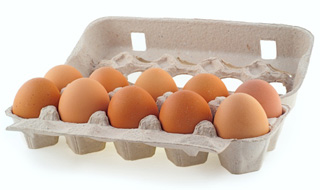What is crude protein
The term “crude protein” is really important to understand before one gets into the merits of its levels in poultry feed, or any feed for that matter. Normal, (wet chemistry) analysis of feed measures the nitrogen content of the feed and then, based on protein containing “on average” 16 % nitrogen, the value analysed is multiplied by 6.25 to arrive at a crude protein value. The assumption that all crude protein contains 16% nitrogen and that all the nitrogen found in feed, or feed ingredients, is actually protein really does result in a crude measure of the true protein in feed and hence the term used to describe it. However, crude protein still has its value as a quick and relatively cheap measure to assess whether theoretical feed formulation and actual feed analysis are comparable.
Essential amino acids
The nutritionist will also use the crude protein value of individual feed ingredients to calculate the amino acid content of these ingredients by using established regression equations. It is the amino acid content itself of feed and the birds’ ability to digest these amino acids that is really far more important than simply the crude protein of the feed. The amino acids are the building blocks of protein and there are 22 of these of which 10 are deemed “essential”. Examples of essential amino acids include lysine, methionine, threonine and tryptophan.
All of the 22 amino acids are used to make up the protein used to produce an egg (or muscle, feathers and skin) but the animal is unable to produce the 10 that are deemed essential through normal metabolism and therefore these must be supplied in sufficient amounts in the diet.
There are many ways to manipulate the crude protein of a feed or feed ingredient using a non protein nitrogen source such as urea or melamine and although this “adulteration” still occurs, it is less frequently found than in previous years due to improved analytical methods available.
Digestibility is important
Two common raw materials we use such as soya meal and meat and bone meal are often exactly the same in crude protein value but the amino acid profiles are actually very different. For example, if both these ingredients are at 48 % crude protein, the essential amino acid, lysine would be 3.05% in the soya and 2.60% in the meat and bone meal. The digestibility of the lysine is 88% for the soya and only 74% for the meat and bone so only 2.68% lysine is actually available from the soya and 1.92% from the meat and bone meal. Despite equivalent crude protein values, meat and bone has a 30% lower available lysine value compared to soya.
Recent research
Excellent recent research published by Pérez-Bonilla et al. (2012) on brown egg laying hens from 22 to 50 weeks of age concluded that irrespective of initial body weight of laying hens, the crude protein requirement for maximum egg production did not need to exceed 16.5%. However, these authors emphasise that this is only possible if the diet meets the requirements for key indispensable amino acids.
The trial was conducted with 3 levels of crude protein in the test feeds (16.5, 17.5 and 18.5%). All feeds had the same energy content of 11.5MJ/kg.
Diets were fed to either low body weight (1 592g) or high body weight (1 860g) hens for the duration of the trial over 28 weeks. The key point is that the 8 critical essential amino acids in all feeds met the digestible levels as recommended by the brown-egg layer supplier.
Effect on performance
These authors found highly significant differences between heavy and light body weight birds for average daily feed intake (120.6 vs. 113.9g), egg production (92.5 vs. 89.8%) and egg weight (64.9 vs. 62.4g) respectively.
The lighter birds gained body weight quicker than the heavier birds and their feed conversion per dozen eggs was significantly better (1.52 vs. 1.57). None of the egg quality variables measured was affected by dietary treatment.
Earlier work by Burley et al. (2009) found similar results when they fed diets that contained the same amino acid balance but differed in dietary crude protein by 0.75 and 1.5% respectively.
Cost savings

Biological limitations
Although it is possible to reduce dietary crude protein levels for layers, there are obviously biological limits to the amount of dietary protein that can be replaced with synthetic amino acids. There is a “tipping” point at which the levels of non-essential amino acids are too low to support maximum egg production and both egg weight and egg numbers will decline.
Talk to us if you have any questions or if you would like to investigate opportunities to reduce the cost of your feeds, while still maintaining performance.
“Crude protein requirement for maximum egg production does not need to exceed 16.5% if all essential amino acid requirements are met.”
